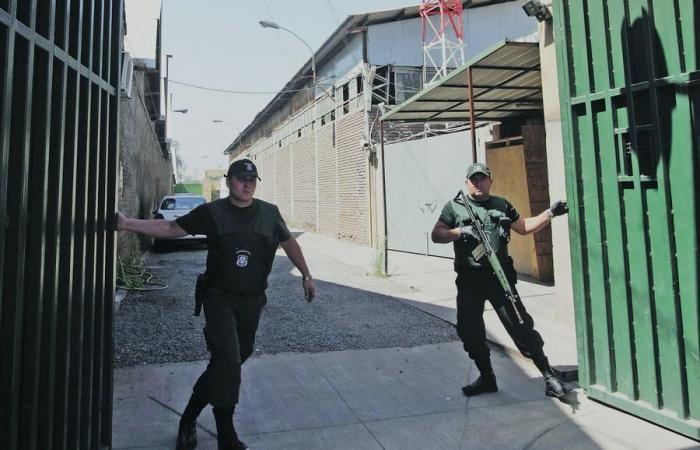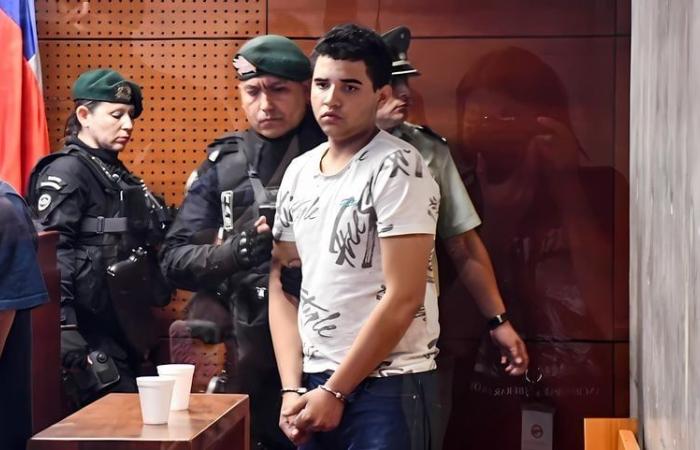“I am a murderer here, everywhere, we can kill them in the street or wherever.”
Between the night of June 5 and the early morning of the following day, serious Disorders occurred inside the Special High Security Penitentiary Complex (Repas), formerly known as High Security Prison. That day, according to the report of the events, the aforementioned phrase was repeated by a group of inmates.
Part of the situation was recorded on a security camera. In these images, six subjects are seen around half of a blue ping pong table. Breaking all protocol, little by little new protagonists begin to appear and scale the walls to reach the patio. Inciting greater calls, The prisoners destroy the table and remove the iron bars from the legs to start hitting the doors of the square courtyard.After almost eight minutes, more than 20 gendarmes arrived to control the situation, which ended with three inmates and 12 gendarmes injured.
“At last CH, who was next to me and He received a blow to the head with an iron bar. And I could see the inmate who hit him, it was Wilker Rondón Márquez,” said one of the officials in the statement that is already in the hands of the prosecutor investigating what happened, Francisco Jacir, of the North Central Prosecutor’s Office.
The incident, which the Gendarmerie clarifies was not a riot but rather “collective disorder,” was caused by a power cut following the rains of that time.
On June 14, the guarantee judge Fernando Guzmán Fuenzalida established several penal precincts. The visit, of a routine nature, led to a report detailing the previous events. After the power outage, the defendants Francisco Valero Castillo, Hernan Landaeta Garlotti and Nestor Jose Mojica Morenowho are in different cells on the first floor of the west wing, were not satisfied with the explanations for the interruption of the supply and began to insult and, according to the report, to threaten to kill some gendarmes. This was reported to the Metropolitan Regional Prosecutor’s Office for the Center North.
A gendarme who participated in the control of the disorders, whose name we will keep confidential, recounts the events and details who participated. “On June 6 of this year, the riot began by the inmates of the Aragua Train, Los Gallegos, the leader of Los Pulpos, those involved in the case of Warrant Officer Palma and Major Sánchez, those in the Malloa caseall led by the hitman and 2nd in command of the Aragua Train, Hernán Landaeta Garlotti, alias “Satan”who within the criminal hierarchy of the gang to which he belongs would come after Carlos González Vaca “The Star”
“What is happening right now in prison is something very serious and urgent that the competent authorities deal with”says the official, who suggests that the shifts in Repas should be rotated with other officials due to their high complexity, and even that the possibility of transferring them to other cities be analyzed. Likewise, he asks that they work with their faces covered and have greater safety equipment.
The next morning, at around 9:40, Valero Castillo, Landaeta Garlotti and Mojica Moreno met with three others, Jose Candurin Melendez, Bryan Sanchez Munoz and Leonardo Vasquez Yzaguirreand the disturbances in the courtyard began. But after the “original rebellion”, as the report states, the problems continued. The accused were transferred to their respective cells, and the destruction of movable objects attached and not attached to the interior of these began. Bathrooms, water pipes and ducts, tiles, glass and window frames, mattresses, etc. were damaged.
“Until now, in Chile we did not have vandalization as a way to intimidate the prison authority. Because what they do, their strategy, is the vandalization of the establishment, not the attack on the gendarmes. It is a strategy aimed at destroying a center where they themselves are. This is the paradox, because in the penitentiary system in general, traditionally people deprived of liberty do not cause damage to infrastructure, because they are the places where they are“explains the Minister of Justice, Luis Corderoto Third.
Guzmán’s report also indicates that the participants are mostly Venezuelans linked to criminal organizations, “with the majority of Chileans staying away.” After June 6, the disorders continued, day after day. All the participants are foreigners and most belong to the Tren de Aragua or its affiliated cells. At least 15 complex events have been recorded so far.
The events forced 18 defendants who did not participate to be transferred to other penal establishments. Those who commit disorders remain in prison. The national director (S) of the Chilean Gendarmerie, Víctor Provoste Torres pointed out that “security measures have been gradually intensified.”specifically to limit the actions of these people, in some cases and in a very specific manner, through the use of coercive elements, with due protection of human rights.”
“The relocation of inmates within the same facility has also been determined, which, along with being a disciplinary measure, allows progress with the repair plan for the damaged cells,” Provoste added.
The disorders – however – have hardened. On the night of June 16, lThe inmates removed galvanized iron bars found outside the cells from their windows, which were already damaged. They did it with the intention of attacking the prison staff, said a source within the Gendarmerie.
Following the chronology, last Tuesday, June 25, another critical moment occurred inside the prison. An inmate broke part of the bathroom in his cell, becoming trapped in a hole he made himself. That day, Gendarmerie shackled seven subjects’ hands and feet for their participation in excesses. These are Ovicmarlixon Garcés Briceño, Wilken Rondón Márquez, Edwars Nava Navarro, Wuilberth Olivares Peña, José Sánchez Álvarez, Jorge Galavis García and Daniel Márquez Meléndez.
The Gendarmerie states that the shackling is “very specific and punctual” and aims to “limit the mobility of the inmates to avoid self-harm, to other inmates and to Gendarmerie personnel, as well as to reduce the possibility of causing damage and destruction.”
But although measures have been taken, the situation has generated tensions in the political environment. The opposition has sent letters to both the Gendarmerie and the Justice Department to reinforce the actions, for the safety of the other inmates, but mainly for the security of the officers.
Amid the questions, the Minister of the Interior, Carolina Tohá acknowledged that there is a crisis in terms of securityalthough he stressed: “Neither government is in a position to stand on a platform and lecture.”
The June 6 revolt was led by “Satan”, one of the most problematic defendants inside the prison. In the D-Day video he is seen fighting off his henchmen and hitting a door with an iron. Landaeta Garlotti, who escaped from prison in Venezuela in 2016 using grenades, was arrested in March 2022 by PDI officers along with six other members of the Aragua Train in Iquique.
Candurin Meléndez and Sánchez Muñoz, two others who participated in the start of the “rebellion,” are behind bars for kidnapping crimes. The first linked to a group called Caracas. He is linked to crimes and lifeless bodies found in Santiago. In February he was one of those benefited by Judge Daniel Urrutia with a video call. Sánchez Muñoz, for his part, was arrested in November 2023 for his participation in the kidnapping of the metallurgical businessman from the O’Higgins Region Rudy Basualto.
“El Estrella”, accused of being one of the leaders of the Aragua Train and who also participated in the events of June 6, had another violent episode in recent days. On the 18th of this month he threatened to kill a gendarme who was taking him to a family visit. ““Calm down, Cesar, we’re going to hang you in the yard, I have a knife in my cell.” González Vaca is accused of the crimes of trafficking in persons under 18 years of age, kidnapping, illicit association, money laundering and illicit drug trafficking, and risks qualified life imprisonment.
Another of those who have participated in these events is Ovicmarlixon Garcés Briceño, who is formalized for the crime of the Carabineros senior non-commissioned officer Daniel Palma, occurred in April 2023. Garcés Briceño is one of the seven subjects handcuffed on June 25. Among that group is also Wuilberth Olivares Peña, accused of the murder of Carabineros Major Emmanuel Sánchez; Galavis García, nicknamed “El culito” and former leader of Los Gallegos, and Márquez Meléndez, nicknamed “El Ruso” and who in May was caught with keys to open handcuffs inside his cell. The latter, a member of Los Gallegos, is facing trial for crimes that occurred in Arica. He is accused of having participated in the crime of two men who were buried alive on Cerro Chuño.
The Gendarmerie has indicated that there has not been an explicit demand from the prisoners, but it is presumed that the inmates feel “the rigor of the regime to which they are subjected and the limitations they have.”
The institution presented on Thursday a complaint by State Security Law against 18 defendants for the destruction and threats. The damages are valued at $197,071,440.
The government has indicated that work will begin on remodeling the damaged elements. This time, “anti-vandal” materials will be used. A team of sociologists, psychologists, criminologists and officers will also create profiles of the accused who participated in the disturbances, with the aim of making possible modifications to the protocols for responding to disturbances.



